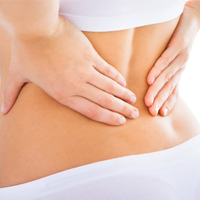Low Back Pain Affecting Your Life And Work

The low back pain is the second most common ailment affecting 80% of the general United States population at some point in life. The pain may either be acute or chronic and is usually caused by a variety of diseases and disorders of the lumbar spine. Low Back pain is usually accompanied by sciatica. Sciatica is a pain that involves the sciatic nerve and affects the lower back, the back of the thighs and buttocks.
Causes and Symptoms of Low back pain
The patient of low back pain may experience two types of pain, primarily – acute and chronic.
The pain is symptomatic and can be caused by the following reasons:
Acute Pain:
A sprain or a muscle tear, which can be aggravated by heavy lifting or extended use of back muscles within 24 hours of the injury, leading to muscle spasms or soreness. Usually improves when you provide rest to the affected area.
Chronic Pain:
This pain may have several causes like –
1.Mechanical Obesity, pregnancy, bad postures while bending, or stooping causes strain on the lower back muscles.
2.Malignancy Low back pain that is not relieved even after a night’s rest, maybe caused by a tumor in the cauda equine (the roots of the spinal nerves controlling sensation in and movement of the legs), or cancer of the prostate, breasts or lungs, maybe caused because of a history of smoking, sudden weight loss or old age.
3.Herniated Spinal Disk When the spinal disk begins to bulge outward between the vertebrae. This is a common cause of chronic back pain in adults.
4.Ankylosing Spondylitis Pain caused while lying down or sitting; improves when the patient starts moving, is commonly seen in males between the age group of 16-35 years.
5.Psychogenic Back pain which may be induced due to an exaggerated minor injury or that may be usually prolonged leading to somatoform disorder or other psychiatric disturbances.
6.Lower Back Pain with Leg Involvement When the back pain radiates down the leg, the sciatic nerve is usually irritated by herniated disks, tumors of the cauda equina, abscesses in the space between the spinal cord and its covering, spinal stenosis, and compression fractures. Some patients may also experience weakness or lack of feeling, along with pain in the leg.


